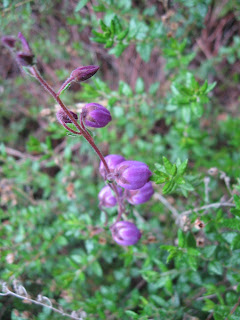These start growing in late summer and eventually get tall and start blooming, seemingly without any care.
Daboecia cantabrica 'Atropurpurea', Irish Heath, has been blooming and continues to bloom, with it's enchanting purple balloon flowers.
A Verbascum phoenicium started by seed last November has gotten big enough to start blooming now, focus is not very good. The others from this sowing seem to want to wait until next year to bloom. A Fibigia is on the left. This is my vole-free gravel-laden bed that can grow peacefully except that lots of little weed seeds keep sprouting.
Some of those long-blooming perennials are still blooming-
Some of those great little Violas, Johnny-Jump-Ups. Not only did they start blooming fast from seed, but then seeded arounnd some little babies that even made it to bloom by fall. Some people don't like their invasive qualities.A few stragglers of the Lychnis coronaria.
It doesn't seem like Fall without the thrill of those flaming leaves in reds, oranges, and yellows. I'm happy to live in a climate where the trees have a long fall to develope them, unlike Denver, Colorado where untimely fall snows turn green leaves into slushy brown ones.
This is my Aronia 'Viking'. I harvested the berries earlier. It is supposed to grow 6' tall but gets taller.
This is Amber Ghost Japanese Maple. The colors became more of a flaming red later but I didn't get out to photograph it.
This is
Hypericum frondosum. It had nice coloration in fall of 2009, pictured here, but is still green today, there must not have been the right cold temperatures for it this year. Burning bushes and maples seemed to color up fine.
Well, I'm spending a lot of time researching the native plants and some vegetables I want to grow next year. It seems a lot of the plants in the mint family, Labiatae, that we all love to grow are non-native- lots of mints, oreganos and other herbs. So I'm getting interested in a group of North American natives, the Agastaches. I am looking at some that are natives and wanting to grow them next year. I did grow one last year, Agastache foeniculum, which did make a nice little plant but it is an imported plant. Hopefully it will bloom next year. The Agastaches have nice aromatic foliage and can be used for tea plants, and are well-loved by hummingbirds, butterflies, and especially bees. The flavors can be minty or can be lemon, anise, licorice, etc. I'm excited to see how well they will do in taking ground away from the weeds and getting large. Mints do well in that respect and when blooming are really aswarm with bees, including a lot of the smaller and native bees. So it will be fascinating to compare them.
Well, this cold weather took everyone by surprise. I hope the cool season greens in my deck stock tank can overweather the frozen conditions out there. And the greens I planted in July. I've been getting some very nice big turnips lately.
Happy Thanksgiving, my menu will feature vegetarian stir-fry with Asian squash, onions, ginger, mushrooms, Shungiku greens (Chrysanthemum coronaria), which I am contemplating growing next year, and water chestnuts; and then some oven-baked Asian eggplants with a little onion, baked to a mouth-watering deep brown perfection.
Hannah










